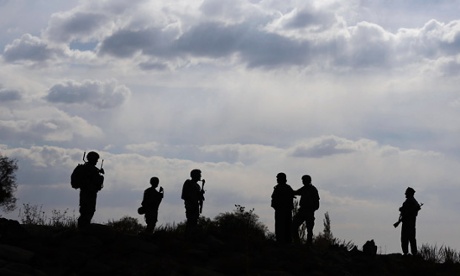
The Army Study to Assess Risk and Resilience in Service members (Army Starrs) uses data from existing army systems and what researchers can collect from soldiers to better understand why soldiers might be at an increased risk for suicidal behavior compared to the civilian population.
Two of the three papers, published Monday in Jama Psychiatry, show the results of surveys and interviews with 5,428 soldiers which looked at the prevalence of mental disorders among non-deployed soldiers and suicidal behavior among currently deployed soldiers. The third study tested common theories about military suicide using historical data.
One major data point from the studies: 1 in 5 soldiers had a common mental illness before enlisting in the army, but were able to clear the military's screening procedures. Intermittent explosive disorder was the most common disorder in the study and was prevalent in the the pre-enlistment population at nearly six times the civilian rate.
"Depression might get a person thinking about suicide, but it's really this history of aggressive, angry outbursts that predicts who acts on their suicidal thoughts," said Matthew Nock, a Harvard University psychologist who led the study on the prevalence of suicide. He said this also holds true in the civilian population.
While the disorder was more prevalent in the military population, pre-enlistment rates for mental illnesses like depression, anxiety and substance abuse mirrored those in the US civilian population. The study authors said the pre-enlistment mental disorders could be targets for early screening and intervention in the military.
"I think what we should strive for is better identification of these problems and the development of more effective targeted prevention and intervention programs," Nock told the Guardian. "Let's identify who might be at risk of negative health outcomes and let's try and help build resilience against those outcomes occurring."
These studies are part of a long-running, multicomponent analysis of military suicide. Researchers will examine more specifically the predictors for military suicide and what factors buffer against the risk.
"This is the beginning of answers, it is not the end," said the National Institute of Mental Health's Michael Schoenbaum, who led the study on the predictors of suicide in the army. This study used a different set of data to show trends, sociodemographic information and army experience for suicide and accident deaths in active duty army soldiers from January 2004 to December 2009, a period in which the suicide rate nearly tripled. The rate continued to rise until 2013, when it dropped back to 2011 levels.
In that time, the rate increased for deployed and non-deployed soldiers. "You can't say they weren't affected by the war, but we can say: 'it's not this simple explanation of you go to war and bad things happen,' because those 40% of people have never been to war and their suicide rate rose," said Schoenbaum.



Comment: The agenda of these studies seems to be to downplay the fact that soldiers are tricked into doing the most horrible, soul destroying things in the imperial wars of the US, and that this leaves permanent scaring on the psyche, if not the soul. The fact that suicide rates are high, even in non-deployed soldiers, shows that involvement in that predatory hierarchy (plus the harsh training drills and psychological dehumanization of "the enemy") causes major distress for normal humans. War and aggression are not our natural state, despite millennia's worth of rabble rousing and divide-and-conquer tactics perpetrated by the psychopaths in power.